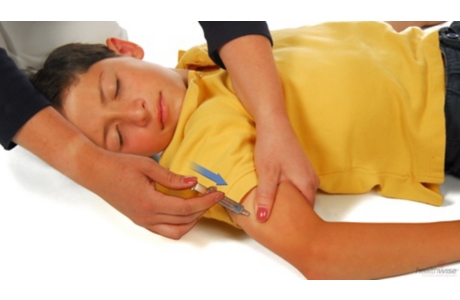Top of the pageActionset
Diabetes in Children: Treating Low Blood Sugar
Introduction
Low blood sugar, also called hypoglycemia, occurs when the sugar (glucose) level in the blood of a person with diabetes drops below what the body needs to function normally. Taking too much insulin, not eating enough food or skipping meals, or exercising more than usual can cause blood sugar levels to drop rapidly.
If your child’s blood sugar level drops very low and he or she does not get help, your child could have a seizure or go into a coma and possibly die.
These four simple steps might save your child’s life:
- Test your child’s blood sugar as suggested by his or her doctor so that you do not have to guess when your child’s blood sugar is low.
- Be alert to the early signs of low blood sugar: sweating, shakiness, hunger, blurred vision, and dizziness.
- Have your child keep some hard candy, raisins, or other foods that contain sugar with him or her at all times. Your child should eat some at the first sign of low blood sugar.
- Teach all of your child’s caregivers what to do if your child’s blood sugar is very low.
How do you deal with low blood sugar?
Low blood sugar levels can develop rapidly, within minutes. Treat low blood sugar symptoms as soon as you notice them.
Here are some ways to manage a low blood sugar emergency.
Be prepared
- Keep some quick-sugar food with your child at all times. These foods include glucose tablets, fruit juice, and raisins.
- Know the symptoms of low blood sugar. Post these symptoms where the list can be seen often, and have your child carry a copy at all times. Add any symptoms that your child has that aren’t on the list. Symptoms of low blood sugar include sweating, blurred vision, and confusion.
- Have your child wear medical identification, such as a medical alert bracelet or a medical alert temporary tattoo, in case your child’s blood sugar drops very low and he or she needs help.
- Keep glucagon on hand. If your child becomes unconscious when his or her blood sugar is very low, someone may need to give your child an injection of glucagon to raise the blood sugar level. Keep the instructions for how to give glucagon with your child’s glucagon. Also, check the expiration date on the glucagon—most glucagon kits need to be replaced every 6 months to a year.
- Teach your child’s caregivers how to check blood sugar. Have instructions for using the blood sugar meter stored with the meter so the caregiver can review the instructions if needed.
- Post emergency care for low blood sugar instructions in a convenient place at home and at school.
Treat low blood sugar early
- Check your child’s blood sugar level if you think it may be low, even if you don’t see any symptoms. Follow the steps for treating low blood sugar when your child develops symptoms of low blood sugar or when your child’s blood sugar is below his or her target range.
- Write down your child’s symptoms and what you did. Use a low blood sugar level record( What is a PDF document? ).
- Let the doctor know if your child is having frequent low blood sugar problems. Your child’s medicine or insulin pump may need to be changed or adjusted.
Credits
Current as of: April 16, 2019
Author: Healthwise Staff
Medical Review:John Pope, MD, MPH – Pediatrics & Adam Husney, MD – Family Medicine & Kathleen Romito, MD – Family Medicine & Stephen H. LaFranchi, MD – Pediatric Endocrinology
Current as of: April 16, 2019
Author: Healthwise Staff
Medical Review:John Pope, MD, MPH – Pediatrics & Adam Husney, MD – Family Medicine & Kathleen Romito, MD – Family Medicine & Stephen H. LaFranchi, MD – Pediatric Endocrinology
This information does not replace the advice of a doctor. Healthwise, Incorporated, disclaims any warranty or liability for your use of this information. Your use of this information means that you agree to the Terms of Use. Learn how we develop our content.




